The Hickox Frank Bridge series on Chandos
Frank BRIDGE (1879 – 1941)
Orchestral Works in Six Volumes
This splendidly conceived, presented and executed Chandos series
treats Bridge with authoritative style and sensitive musicianship.
In this it matches Chandos banner series for Grainger, Schmidt,
Enescu, Glazunov, Bax and Harty. Bridge’s music is getting to
the stage where it will no longer need special pleading. The
series appeared in an unhurried way – no gabble, no exploitative
rush. Nothing wrong with that if the results are as good as
this. Taking time can produce a better effect even if the loyal
enthusiasts were chafing for each new release.
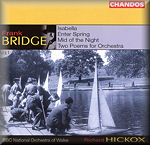 Frank
BRIDGE (1879 – 1941)
Frank
BRIDGE (1879 – 1941)
Orchestral Works: Volume 1
Enter Spring (1927) [1836]
Isabella (1906) [1800]
Two Poems for Orchestra (1915) [1255]
Mid of the Night (1903) [2606]
 BBC National Orchestra of Wales/Richard Hickox
BBC National Orchestra of Wales/Richard Hickox
rec Brangwyn Hall, Swansea, November 2000
 CHANDOS CHAN 9950 [75:48]
CHANDOS CHAN 9950 [75:48] 
Arkivmusic
MDT
AmazonUK
AmazonUS
Sound
Samples & Downloads
An elementally remorseless Enter Spring is this disc’s
centrepiece. It is his greatest work - a single movement nature
symphony as ineluctably compelling as Alwyn's Hydriotaphia,
Lambert's Music for Orchestra, Rubbra's Fourth or Eleventh
or Havergal Brian's Symphonia Brevis.
The first volume in the Bridge series had what was to become
the mark of series. The works were mixed to add the familiar
and almost standard with the unfamiliar and practically unknown.
It also consolidated the impression that this was going to be
a long term and thorough commitment. And so it turned out.
Enter Spring is given a confident and wondrously
transparently recorded outing. The whispered trumpet fanfares
are magical: as at 5:28. The great brass statements roll out
in sovereign confidence touching on Bax and even Moeran. It
is the aural equivalent od Frank Brangwyn's March of Spring
in the Lady Lever Art Gallery at Port Sunlight. Enter spring
is mature Bridge and a stunning masterpiece. Isabella is a 1905
tone poem. This is confident and can be bracketed with the contemporaneous
works of Holbrooke, Bantock and Boughton - similar experiments
were in hand in the USA a from the likes of Coerne, Farwell
and before him Macdowell. They inhabit a lavishly imaginative
poetic world which takes Tchaikovsky and Rachmaninov as models.
Such experiments seemed to thrive among pupils of the Royal
Academy where they were usually nipped in the bud at the RCM.
The horns in the relaxed introduction are rich and warmly heated.
Isabella has previously been recorded for Pearl. This
Chandos Hickox version is a luxury item by comparison.
The Two Jefferies Poems date from the depths of the Great
War. They are of greater luxuriance though not as deftly expressionist
as There is a willow. They reflect a world and a mind
in transition. I have loved them for many years especially the
second. The first inhabits the warmly bathed somnolent ecstasy
of Bax's Spring Fire and Enchanted Forest. The
second is ore dynamic and vernal with its chuckling blood-rush
being more akin to the recreative conflagration of Enter
Spring and the more animated sections of Summer. In these
two works it is as if Bridge had distilled the poetic aspects
of Summer and the rushing dynamism of the same work. They are
superb. Mid of the Night is a very extended tone-poem
in the same mould as Isabella. His music seems to find
its centre of emotional gravity with Tchaikovsky's Hamlet
and Fatum. The 24 year old composer had at last been
let off the leash held by Stanford. Much the same applied -
though a few years later - to John Ireland whose experience
of Stanford was bruising. The delicacy of the later Bridge pieces
recalls the orchestral works of William Baines. While Baines’
symphony is not at all impressionistic, his two tone poems (Isle
of the Fey and Thoughtdrift) as well as the Poem
for piano and orchestra are a collected works project crying
out for the attention of Chandos.
The notes are by Paul Hindmarsh. I recall a time, not all that
long ago, when his extended pamphlet was all that was available
on Bridge. How things have changed!
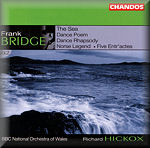 Frank
BRIDGE (1879-1941)
Frank
BRIDGE (1879-1941)
Orchestral Works: Volume 2.
Dance Rhapsody (1908) [19.20]
Five Entr'actes from Emile Cammaerts's play The Two
Hunchbacks (1910) [12.08]
Dance Poem (1913) [14.01]
Norse Legend (1905/1938) [4.50]
The Sea - suite (1908) [22.10]
 BBC National Orchestra of Wales/Richard Hickox
BBC National Orchestra of Wales/Richard Hickox
rec Brangwyn Hall, Swansea, 19-20 Sept 2001 DDD
 CHANDOS CHAN 10012 [72.37]
CHANDOS CHAN 10012 [72.37] 
Arkivmusic
MDT
AmazonUK
AmazonUS
Sound
Samples & Downloads
LPO conducted by Nicholas Braithwaite were recorded by Lyrita
in the two dance titled works. These were revelatory events
full of sweep and panache aided by the LPO's virtuoso precision.
The Dance Rhapsody is an eruptive and dionysiac
with strange premonitions of Nielsen and even de Falla. Though
nowhere near as revolutionary (parts of it sound Elgarian) the
instinctive spark derives from the same arousal and charge as
Grainger's ballet The Warriors.
The Entr'actes soothe and tickle, lilt and sing.
They are gentle unassuming creations which fit well alongside
the acreage of light music created by British composers during
the first half of the 20th century. They stand in the Royal
Enclosure by comparison with the tired generality of much of
this output. The Norse Legend (originally for
violin and piano) is another light and slight genre piece.
The Dance Poem stands closer to the chill of There
is a Willow and though broadly contemporaneous with the
idyllic Summer it is far distant from the direct romantic
giddiness of the Dance Rhapsody. Although there is at
least one eruption it is far more knowing; rather like the rollicking
climax that tops off the tango movement of Samuel Barber's
suite Souvenirs. There are a surprising number of Baxian
fingerprints too. The episodes in the Poem are: The Dancer;
Allurement; Abandon; Tenderness; Problem;
Disillusion. Does this chart the course of an affair
turned to ashes?
The Sea, the work that with Enter Spring,
bowled over the young Britten, was written in Eastbourne, the
same seaside town where Debussy had completed his La Mer.
Surely Bax was influenced by this work in his Tintagel -
listen to 2.10 and 3.04 tr. 9. Is that a quote or what? The
Bridge work is lucidly textured, avoiding the wash and swell
of impressionism; instead Bridge paints in broad swathes of
melody. This is a remarkably fine performance to put alongside
those of Groves/RLPO (EMI,
1977) and Handley/Ulster (Chandos, 1980s). Most impressive of
all is Hickox's way with the Storm movement (tr. 12)
with the loud crash of combers and the scattering smithereens
of spume. In all this the detail of the harp part is not lost.
Notes are again by the leading Bridge authority, Paul Hindmarsh.
Every detail of this production speaks of the most exalted qualities.
Rob Barnett
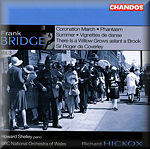 Frank
BRIDGE (1879-1941)
Frank
BRIDGE (1879-1941)
Orchestral Works: Volume 3
Coronation March (1911) [6.46]
Summer (1914) [10.42]
Phantasm (1931) [24.21]
There is a Willow Grows A Brook (1927) [11.18]
Vignettes de Danse (1938) [11.20]
Sir Roger de Coverley (A Christmas Dance) (1922)
[4.41]
 Howard Shelley (piano)
Howard Shelley (piano)
BBC National Orchestra of Wales/Richard Hickox
rec. Brangwyn Hall, Swansea 27 Nov 2000 (Sir Roger);
28-29 Nov 2002. DDD
 CHANDOS CHAN 10112 [69.55]
CHANDOS CHAN 10112 [69.55] 
Arkivmusic
MDT
AmazonUK
AmazonUS
Sound
Samples & Downloads
Bridge came of a generation riven by the Great War. The composers
of that epoch were also stung, inspired or troubled by new musical
currents from Vienna. Bridge may be seen as a follower of fashion
as his music changed style over the period from 1911 to 1938.
A Tchaikovskian romantic with an impressionistic palette (Dance
Poem and Dance Rhapsody) evolved into a composer
whose range of expression took in the harmonic adventures offered
by Berg, Schrecker and Zemlinsky (Oration and Phantasm).
If his music suffered a critical ice age his conducting remained
in demand although not sufficiently to command major fees let
alone more than a speckle of recordings.
This Chandos collection takes us from the snappy pomp and lyricism
of the Coronation March via the Butterworth and Ravel
of Summer to the first stirrings of Continental accents
in There is a Willow to the masterly ambivalence and
mildewed expressionist complexity of Phantasm.
The March repays several hearings as its lyrical facets
register more strongly over the celebratory snap and clash.
This is its world premiere recording and it is worth hearing
though certainly written against Bridge’s pacifist character.
The competition for which he wrote the piece did not award any
prizes that year. I wonder what else was entered.
In Hickox's Summer one can feel the slow warmth of the
sun in the veins just as much as the shimmering vigour. Del
Mar on a now elderly recording with the Bournemouth Sinfonietta
(also Chandos) makes a more breezy magic but Hickox is excellent
at the Delian languor and slow blooming woodland magic.
Phantasm is a major piece of the utmost seriousness of
mood. While works such as Summer, The Sea, the
Two Poems and the two early dance works expound on sky,
scenery and open air Phantasm is a psychological rhapsody.
It is work that has not been frequently recorded. Indeed there’s
only a few competitors on CD (Dutton
– once Conifer - Stott/RPO/Handley with the Walton Sinfonia
Concertante and the Ireland Concerto) and (Lyrita).
It inhabits a land of mildew and troubled reflection like parts
of Bax's Winter Waters and Saga Fragment. There
is some ruthless nightmare music as at 6.34 which rises to a
sour heroic rhythmic military gesture for horns and piano. The
solo writing is akin to Prokofiev’s Third Concerto with transient
harkings back to the earlier idyllic style at 7.54. There is
nothing of decoration in this piece; more a case of a finger
trailing through stagnant waters and ruthless threats carried
by the emphatic writing for brass and piano. Indeed it reads
like a prophet’s warning. The depressive mildewed poetry of
There is a Willow continues the theme of darkness in
music and hovers close to the instrumentals in Warlock's Curlew.
I rather like Neville Dilkes' old version on EMI but this outstrips
the audio quality of that analogue version. Hickox's lugubriously
reflective way with the piece works extremely well.
The Vignettes de Danse were orchestrated in 1938 from
a suite of Mediterranean sketches originally written in 1925.
These ‘postcards’ are a set of subtle chiaroscuros - much more
sophisticated and fragile than say Bax's Mediterranean
or Holst's Beni Mora and more delicate than Ibert's Escales.
The disc ends with a brief dance which I have known previously
only in its versions for string orchestra (Decca, Britten) and
string quartet. This, most unusually, is for full orchestra
and the treatment is fully coloured like an intensely imaginative
dance fantasy with moonlight and stars set adrift. The finale
in which the tune ‘Roger de Coverley’ intertwines masterfully
with ‘Auld Lang Syne’ still works its enchantment. Even so it
lacks Britten and the ECO's carefully weighted judgement and
suffers in comparison. This is the sort of piece that would
pair well with Chabrier's España or Barber's Souvenirs.
Beecham would have made much of this if only he had been tempted
to take it up.
There is no directed competition for this disc. It is highly
attractive as a collection. I would not want to be without Del
Mar's Summer, Dilkes' There is a Willow or Stott's
Phantasm which is leaner though not as threatening as
Shelley's and Hickox's.
Rob Barnett
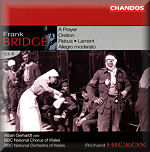 Frank
BRIDGE (1879-1941)
Frank
BRIDGE (1879-1941)
Orchestral Works: Volume 4
Rebus - Overture for Orchestra (1940) [10:44] (premiere
recording on CD)
Oration (Concerto elegiaco) for solo cello and
orchestra (1930)* [29:16]
Allegro moderato - Fragment of a symphony for string
orchestra (1940-41) [13:24] (edited by Anthony Pople)
Lament for string orchestra (Catherine, aged 9, 'Lusitania'
1915) (1915) [5:21]
A Prayer for chorus and orchestra (1916-18)† [17:55]
 Alban Gerhardt (cello)*
Alban Gerhardt (cello)*
BBC National Chorus of Wales †
BBC National Orchestra of Wales/Richard Hickox
rec. Brangwyn Hall, Swansea, 13-14 May 2003
 CHANDOS CHAN 10188 [77:00]
CHANDOS CHAN 10188 [77:00] 
Arkivmusic
MDT
AmazonUK
AmazonUS
Sound
Samples & Downloads
Bridge’s music has undergone a rocky and desultory renaissance.
In the 1950s and 1960s there was precious little available unless
you were prepared to track down rare 78s or trade home-spun
tape recordings of BBC broadcasts. In the 1970s things began
to change. EMI Classics recorded an LP’s worth of orchestral
music including Enter Spring and The Sea with
Groves and the RLPO (JQ
RB).
Groves had already conducted a dazzling performance of Enter
Spring at the 1978 Proms with the BBC Symphony Orchestra
- now that would be well worth issuing if someone had
a presentable tape. As we know from a BBC Legends CD, Britten
had paid practical tribute to Bridge mounting performances of
both works at the Maltings Snape during the 1960s. Decca issued
the Allegri recordings of the grittiest of his string quartets:
numbers 3 and 4, as well as the spare and dissonant Piano Trio
No. 2 (on Argo – now Lyrita).
Pearl had a double LP of his piano music and songs in 1971 including
the grim Piano Sonata. Lyrita issued most of the orchestral
music between 1978 and 1982 but these valued and often inspirational
recordings by Boult
(LP SRCS 73) and Braithwaite
(LPs SRCS 91, 104, 114) slipped into an oblivion in 1983 from
which they emerged on CD only in 2007. At least EMI Classics
kept their Bridge/Groves miscellany in the catalogue. Pearl
produced the opera The
Christmas Rose and a far from modest crop of LPs and CDs
of the chamber music, piano solos, songs (Tagore), choral
works (A Prayer) as well as diminutive (Norse Legend)
and not so diminutive (Isabella) orchestral pieces. They
also had a quite extraordinary CD (SHECD9601) of Enter Spring
and Oration. This featured performances by John Carewe
conducting the Cologne Radio Symphony Orchestra with Alexander
Baillie (cello) in Oration. If ever Pearl felt moved
to issue their recorded Bridge legacy (analogue and digital,
please) in a single boxed set it would be likely to be greeted
very warmly - if only they would! Continuum had all the piano
music on four CDs and all four quartets on two CDs. Meridian
have done well by Bridge (the four string quartets) as also
have Hyperion with the latter producing a complete edition of
the songs
as well as a smattering of the chamber music.
The present Chandos selection gives us three works of his uncompromising
older age from 1930 to 1941 as well as two more lyrically accessible
examples from the teens of the century both written during the
axle-turn of his life: The Great War. That very war swept away
the softer innocence and pastoral delight and opened the eyes
and mind to brisk and bracing currents from the Continent. Bridge
began to find a new voice but few critics of the time reacted
well to it. His Summer and The Sea delighted the
Edwardians and later romantics but what were this generation
to make of the nightmares of the Piano Sonata, the last two
quartets and the Piano Trio No. 2; never mind the enigmatic
Oration and Phantasm. Even when he returned to
the countryside in Enter Spring and the Two Jefferies
Poems the language, while even more intoxicating, had an
unnerving allure that was strange to those brought up on his
Tchaikovskian tendencies.
Oration: According to the work's first soloist,
the cellist Florence Hooton, Bridge gave the concerto the principal
title Oration because he wanted it to be not only a passive
elegy (its subtitle is Concert Elegiaco) but also
a protest against war. He had been gripped by that theme
in the Piano Sonata of 1924 dedicated to his young pupil Ernest
Bristow Farrar who had been killed in the trenches. Oration
was completed in 1929-30 and was rejected by three other cellists
before finding Hooton. Felix Salmond was to have premiered it
in Chicago but didn't, Guilhermina Suggia turned down a BBC
broadcast as did Lauri Kennedy. It was broadcast finally on
17 January 1936 after three grand rehearsals and was warmly
greeted by Ernest Newman, not a great admirer of Bridge's later
style. A set of discs was made of the premiere and these are
still held by the Frank Bridge Trust (a chance here for Symposium
surely even if the original engineer did omit a couple of bars).
There was one other broadcast, 6 December 1936, and the piece
then sank without trace until revived in the 1970s by the young
cellist Thomas Igloi with the English Chamber Orchestra conducted
by Frederick Prausnitz in 1975.
Julian Lloyd Webber made the first commercial recording of Oration.
His is an unsentimental approach in which steadiness of tone
production and a refined natural sound quality go to produce
a very fine result in the best analogue traditions of Lyrita.
Braithwaite lets the hysteria build organically to an angry
peak (15:23). The luminous recording quality can be heard at
12:31 in the quiet skein of sound through which the harp momentarily
peeps out. Lloyd Webber takes 27:30 as against the 31:20 from
Alexander Baillie on the rare and sadly deleted Pearl CD SHE CD
9601 from 1987. The Baillie version works well although his
tone is not quite as cleanly produced as Lloyd Webber's and
the soloist's final note does not float free with quite the
pristine soprano purity you get on Lyrita. Steven Isserlis on
EMI Classics CDC 7 49716 2 (much reissued) in 1988 takes 30:24.
He is with the City of London Sinfonia conducted by the very
same Hickox who now conducts the BBC Welsh with Alban Gerhardt.
Gerhardt is an intriguing choice and not one I had predicted.
After all during 2000 Hickox conducted Oration with the
BBC Welsh and Chandos regular Raphael Wallfisch, for BBC Radio
3. The engineering quality on the Chandos is very clean, achieving
good transparency if without the silk and canvas strength of
the fabulous Lyrita. By comparison the no-nonsense radio studio
balance for the Pearl, done by German Radio WDR, Otto Nielsen
and Klaus-Dieter Harbusch, is meaty and not at all sketchy.
On the other hand the playing of the orchestra especially in
the epilogue is outstanding and Isserlis almost matches the
enigmatic singing quality luminously achieved by Lloyd Webber.
The Chandos recording perspective is spectacular, probably the
best it has ever had. It is very much in the most exalted Decca
manner though not at all what you would hear in the concert
hall. The cellist is given a microphone eminence which is extremely
commanding, exciting, flamboyant and gratingly moving. That
epilogue is deeply affecting, tender through the soloist's voice
yet bleakly haunted like the second movement of Havergal Brian's
Gothic. It is related also to the extended finale to
RVW's Sixth Symphony.
The 1940-41 Allegro moderato for string orchestra
is all that remains of a projected symphony for strings. In
fact the last few bars were left unfinished on Bridge's death
and were ‘completed’ by Anthony Pople. This too was issued on
LP by Lyrita on SRCS 104 which has been reissued on Lyrita
CD. This is a classically clean work and very romantic for
that time when you compare it with the bustle and elfin dissonance
of Rebus.
The 1915 Lament has been recorded several times
before. Strange how returning to it after a longish time I hear
more predictions of the sourer Bridge from There is a willow
grows aslant a brook than I did previously. It is warm but
there are harmonic eddies and depths that look forward at least
a decade.
A Prayer to words by Thomas à Kempis takes us
down a road Bridge did not go down again except, to some extent,
in the opera A Christmas Rose (on Pearl). It is Bridge's
only work for chorus and orchestra and is an invocation to peace.
The orchestration was completed in October 1918. The work was
premiered in the great spaces of the Royal Albert Hall in January
1919 and then revived in 1935. Its style now sounds rather Finzian
(5.04 onwards) and warmly cocooned. It receives here a very
fine performance There is some lovely antiphonal work superbly
captured by the Chandos team. That high exposed ppp singing
recalls Holst's Ode to Death written for Cecil Cole,
another young composer victim of the Great War. It is not the
equal of the Holst, which has a mystical spirituality not quite
attained by Bridge, but it remains a work of candid sincerity.
Its two previous recordings are a moving but rather fleet-footed
version (all over in 15:07) on a Pearl LP (Chelsea Opera Group/Howard
Williams) and most recently a recording by Liverpool forces
conducted by Douglas Bostock (ClassicO).
Hickox's measured pace works very well and is extremely moving,
reminding me also of parts of Hickox's Chandos set of Dyson's
Quo Vadis at O whither shall my troubled muse incline
where, at 3.48, we seem to hear the marching tread of starry
soldiery.
Rebus was originally entitled A Rumour
(like the Cowell piece once recorded by Neville Marriner). It
was written in 1940 and would have been in that year’s Prom
season had it not been cancelled due to the Blitz. In fact it
had to wait until 23 February 1941, just a month after Bridge's
death, before it gained a hearing. Apart from some threatening
and inimical shadows and an occasionally ruthless tread this
is a bustling determined and fairly romantic little concert
overture with Elgarian and even Waltonian moments. The recording
by Lyrita and Braithwaite has that additional smashing tension
but there is not much in it.
Rebus has been recorded before but never on CD.
It first emerged in recent years in a BBC broadcast by the English
Chamber Orchestra conducted by Frederick Prausnitz in 1975.
Then in the late 1970s the LPO and Nicholas Braithwaite recorded
it on Lyrita LP SRCS 114 now on Lyrita
CD.
This all adds up to a very fine addition to the Chandos series.
It stands up extremely well in the Bridge discography being
perceptive, varied, sensitive, excellently performed and recorded
and generously assembled. Not a hint of series burnout here.
It is superbly documented by Bridge expert Paul Hindmarsh.
Rob Barnett
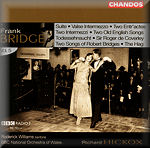 Frank
BRIDGE (1879-1941)
Frank
BRIDGE (1879-1941)
Orchestral Works: Volume 5
Suite for Strings (1909-10)
The Hag (1902) *
Two Songs of Robert Bridges (1905-06) *
Two Intermezzi from ‘Threads’ (1921/38) *
Two Old English Songs (1916)
Two Entr’actes (1906/36)
Valse Intermezzo à cordes (1902)
Todessehnsucht (1932/36)
Sir Roger de Coverley (A Christmas dance) (1922/39)
 Roderick Williams (baritone) *
Roderick Williams (baritone) *
BBC National Orchestra of Wales/Richard Hickox
Rec. Brangwyn Hall, Swansea, 3-4 December 2003. DDD
 CHANDOS CHAN 10246 [68:17]
CHANDOS CHAN 10246 [68:17] 
Arkivmusic
MDT
AmazonUK
AmazonUS
Sound
Samples & Downloads
The Suite for Strings has been recorded not infrequently. Boult's
full analogue version for Lyrita is closest to this. Less full
fat is the version by Norman del Mar but it still comes across
as a romantic work and Hickox lets this have full rein. The
models are surely Tchaikovsky's Serenade as well as the
Elgar and the Introduction and Allegro.. Also impressive,
in the same idiom, are the wonderful American counterparts recorded
by Dutton
Epoch. There is also a touch of Grieg as well as Last
Spring. The second movement has a spring in its step and
recalls the wonderful Sir Roger de Coverley which for
years depended on the Decca recording made by Britten with the
ECO. That was my route into the piece. For all that it is an
early work the Suite is very much of the same stamp as Sir
Roger de Coverley. Wit, excitement and beguiling enchantment
are all there. How did Bridge remain so many years in
the outer darkness?
From 1902, The Hag is a macabre nightmare - a howling
gale of a piece, reeking of brimstone. Roderick Williams does
not short-change us. The Hag was also set by Havergal
Brian for choir. Poul Schierbeck, the Dane, wrote his own Haxa
which inhabits much the same world. The two songs of Robert
Bridges were recorded first by Pearl in their occasional
SHE series. Williams caresses the I praise the tender flower.
It's luxuriant writing with a Delian temperament. Thou didst
delight mine eyes starts with strange dark melodrama. It
soon flutters in feathery lightness and troubadour serenading
and the rushes onwards in a way that recalls Delius's orchestral
songs.
The orchestra only retruns for Two Intermezzi from Threads
- incidental music from 1921.The first is quite Delian while
the second has the same flaring upheaval as the second of the
two Poems heard on Volume. Then come the sweetly and tenderly
arranged Two Old English Songs which may well have had
some effect on Quilter. Sally in our Alley and the rushing
Cherry Ripe represent an early limbering up for the richly
contrapuntal Sir Roger de Coverley. More in the light
music vein and closer to the Elgar genre pieces for small orchestra
are Rosemary and the slowly bell-tolled Canzonetta
which recalls Turandot. The Valse Intermezzo is
also an early piece –same vintage as The Hag. It is smoothly
contoured: sweet and light. The Todesehnsucht (world
premiere recording again) is more reverentially dignified in
this sombre arrangement.
The notes are by Paul Hindmarsh again.
To end Hickox unleashes the wit and rapier flickering of Sir
Roger. It's a superb piece which you think might be inconsequential
but soon develops in its precise and concentrated 4:24 the strength
of the Tchaikovsky and Dvorák serenades for strings.
Rob Barnett
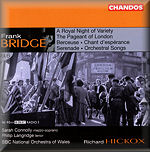 Frank
BRIDGE (1879-1941)
Frank
BRIDGE (1879-1941)
Orchestral Works: Volume 6
Blow out; you bugles H.132 (1918) [05:38] (1); Adoration H.57
(1905/1918) [02:58] (1); Where she lies asleep H.114 (1914)
[03:03] (1); Love went a-riding H.115 (1914) [01:41]; Thy hand
in mine H.124 (1917/1923) [02:12] (1); Berceuse H.9 (1901) [05:09]
(2); Mantle of Blue H.131 (1918/1934) [02:49] (2); Day after
day H.164(i) (1922) [04:55]; (2); Speak to me; my love! H.164(ii)
(1924) [06:00] (2); Berceuse H.8 (1901/1902/1928) [03:26]; Chant
d’espérance H.18(ii) (1902) [03:45]; Serenade H.23 (1903) [02:53];
The Pageant of London; Suite for Wind Orchestra H.98 (1911)
[15:11]; A Royal Night of Variety H.184 (1934) [01:27]
 Sarah Connolly (mezzo) (2), Philip Langridge (tenor) (1)
Sarah Connolly (mezzo) (2), Philip Langridge (tenor) (1)
BBC National Orchestra of Wales/Richard Hickox
rec. 23-24 October 2004, Brangwyn Hall, Swansea, Wales
 CHANDOS CHAN 10310 [61:13]
CHANDOS CHAN 10310 [61:13] 
Arkivmusic
MDT
AmazonUK
AmazonUS
Sound
Samples & Downloads
For volume 6 we hear premiere recordings of nine songs for solo
voice with orchestra. Five are for tenor (Langridge) and four
for mezzo (Connolly). His 1918 setting Blow out you bugles
from the last year of the war is superbly orchestrated -
such jewelled detailing. There are some striking bugle fanfares
and an heroic ambience. It sets Rupert Brooke who died in 1915
yet the sentiments - while a delight to hear - would sit uncomfortably
with a work such as Bliss’s Morning Heroes or RVW’s Dona
Nobis Pacem.
Adoration sets aspirational Keats. Mary Coleridge's Where
she lies asleep is a tremblung fragile song. More Coleridge
in the galloping Love went a-riding, a very familiar
song. It includes some triumphant stuff redolent of Mahler's
Lieder eines fahrenden gesellen. Thy hand in mine
is a short song.
Then come the mezzo songs. Berceuse is a setting of Dorothy
Wordsworth. This is gently yet securely done by Connolly on
waves of romantic feeling. Mantle of blue also set by
Bax, Moeran and Gurney is by Padraic Colum. The words O men
from the fields evoke a lovely heat haze made explicit by
the music. Lastly there are two songs setting poems by Tagore.
These are suggestive and impressionistic rather a step on from
the same territory inhabited by Mantle of Blue. These
are most beautiful Delian style songs yet more saturated in
lyrical confluence. Much the same goes for the last of the nine
songs, Speak to me my heart. This inhabits the world
of Baines’ Thoughtdrift and Island of the Fey.
These songs stand little chance of concert life - at least not
in this format despite often having a big Mahlerian heart and
a gift for tenderness.
Berceuse is a heart-wide genre piece. Chant d'esperance
is a feathery stately dancing piece - suggestive of ballrooms.
Serenade is another Tchaikovskian piece, light on the
palate, and passing by absorbed in its own elegance.
The Pageant of London is for wind band. It was written
for a London street pageant for the Coronation of George V in
1911. The solemn march, Richard III leaving London is
grandly Elgarian. First discoveries looks to Tudor times
and with its Pavane and La romanesca we catch
a hint of the flavour of those days as filtered through an Edwardian
sensibility. The finale is another march, Henry VIII enters
London. Now Bridge sheds the pastiche and delivers a march
with a more soldierly spirit about it. It's not one of his best
though: something of a pot-boiler.
Suitably the disc and the series closes with A Royal Night
of Variety from 1934. This so-called epilogue must have
made an unwelcome response to the commission for it is a subtle
shading down from fanfare to gentle farewell gesture.
Again the notes are by Paul Hindmarsh.
Rob Barnett
THE BRIDGE SERIES ON CHANDOS
Volume 1
http://www.musicweb-international.com/classrev/2002/Jan02/Bridge_Enter_Spring.htm
http://www.musicweb-international.com/classrev/2001/Nov01/Bridge_orchestral1.htm
Volume 2
http://www.musicweb-international.com/classrev/2002/Nov02/bridge_chandos2.htm
Volume 3
http://www.musicweb-international.com/classrev/2004/Jan04/Bridge3.htm
http://www.musicweb-international.com/classrev/2004/Feb04/Bridge3.htm
http://www.musicweb-international.com/classrev/2003/Dec03/Bridge3.htm
BRIDGE ON MUSICWEB INTERNATIONAL
Frank Bridge (1879-1941) Composer, Courageous Revolutionary
And Pacifist by Rob Barnett A Len Mullenger commission This
is a long article of 9000 words
http://www.musicweb-international.com/bridge/index.htm

